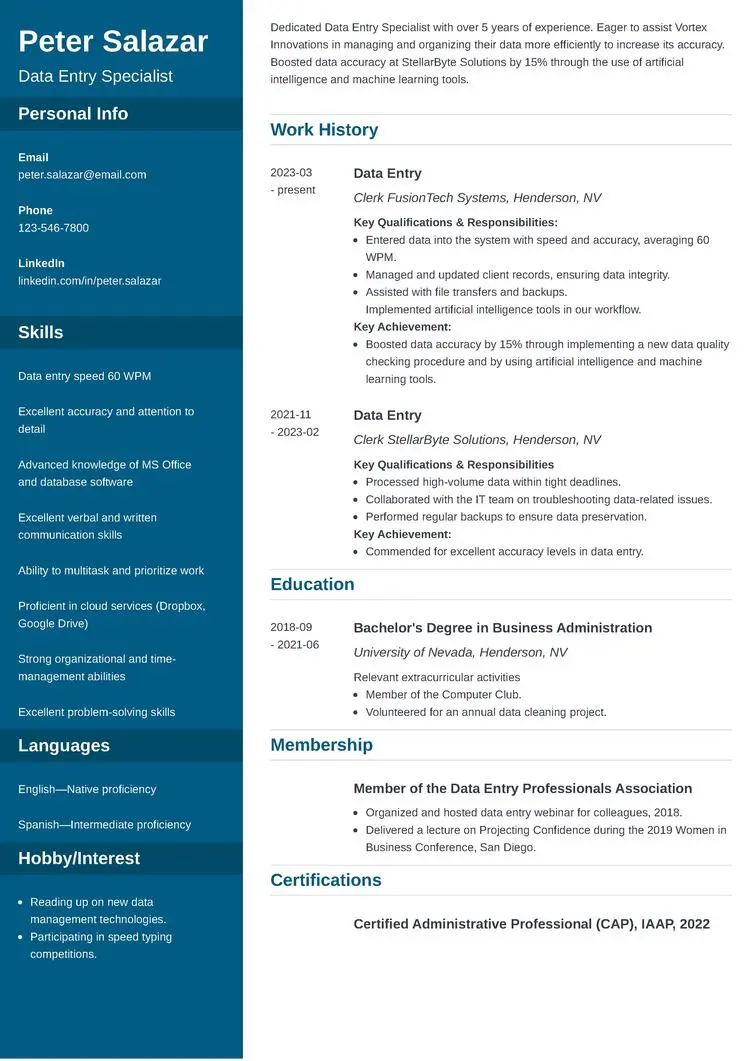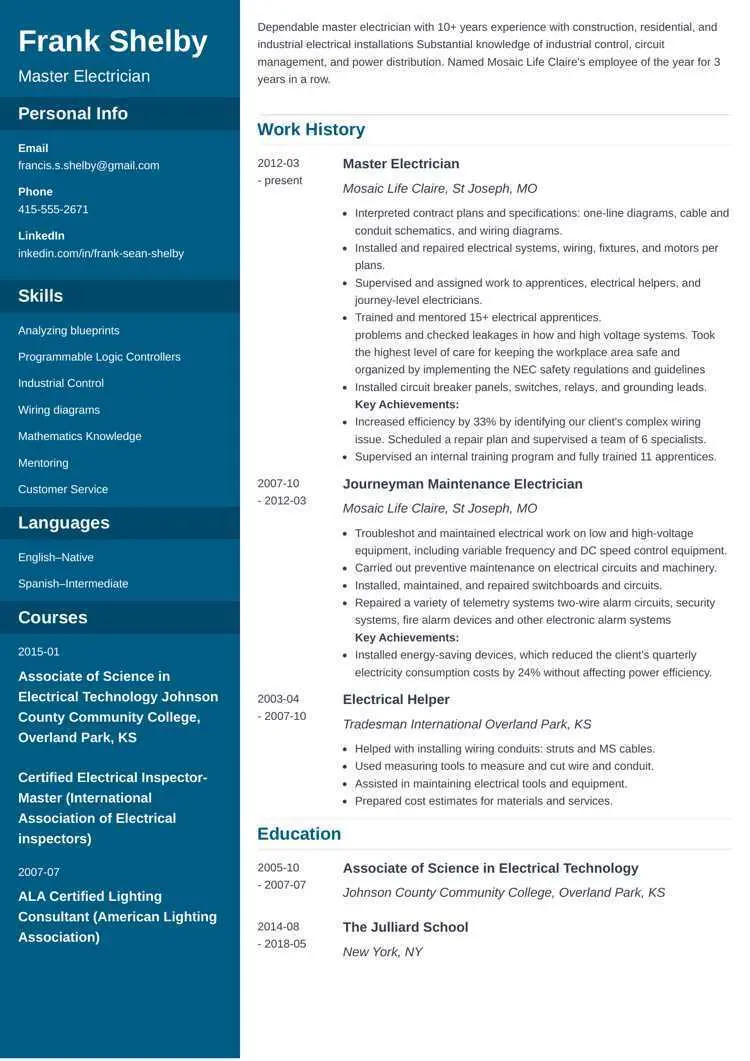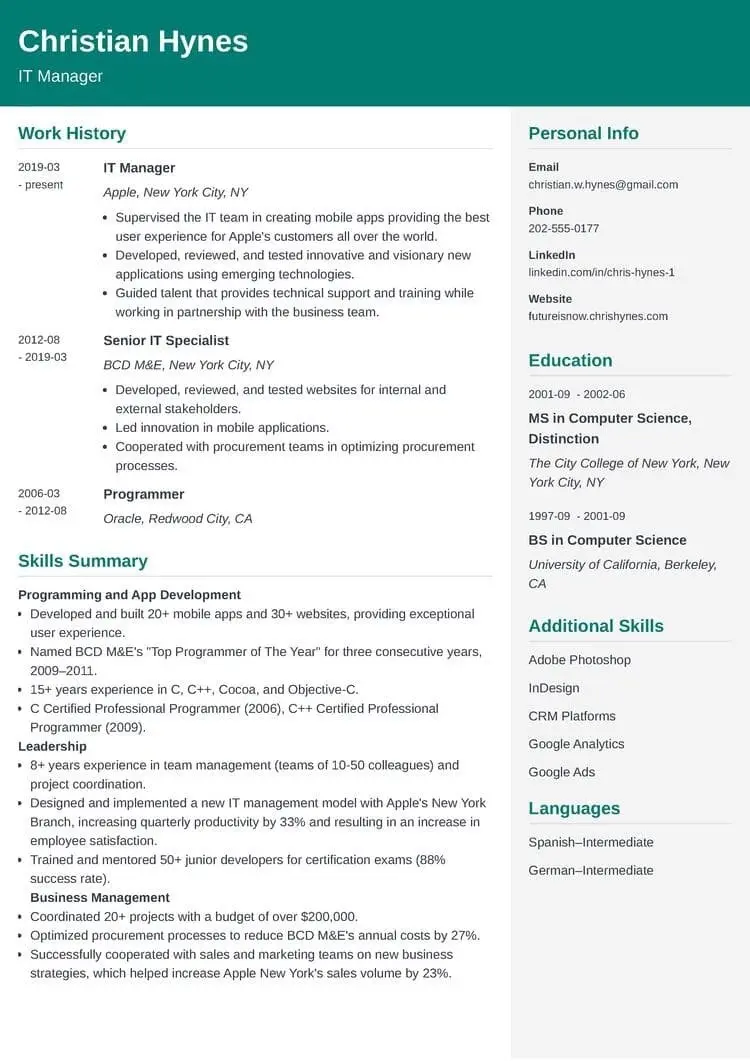Best Resume Format: Tips, Examples & Templates (2025)
Create Your Resume NowYour resume’s format plays a critical role in whether or not you land an interview. Even if your experience is impressive, poor formatting can make it hard to read, look unprofessional, or fail to land on your potential employer’s desk.
In this article, I’ll show you the best resume format, explore the most common formatting mistakes, and provide detailed formatting tips to ensure your resume looks polished and professional. Let’s begin!
What Is the Best Resume Format?
The best resume format in 2025 is a chronological resume format. It’s also the most common resume format, working perfectly for most candidates. Plus, it’s recruiters’ all-time favorite, so it’s hard to go wrong choosing a chronological resume as your current resume format.
It’s important to tailor your resume to the job offer, but better to stick to one resume format for all applications. Here’s what Milena Makowska, Senior Talent Acquisition Specialist, has to say about best resume format:
Think about it: an average job opening attracts hundreds of resumes. If you follow a specific resume format, you will make HR’s job much more manageable. Many of us consider chronological resumes as our go-to resume format. We know it best; it’s easy to scan, and we can see what you’ve been up to most recently.
If you’re writing a resume that will be read in the USA, you should follow these additional rules: US Resume Format (American Style Resume Template).
How to Format a Resume: Formatting Tips
The way your document looks is vital. After all, as I wrote in Zety’s HR statistics report, a recruiter looks at a resume for about 7 seconds. If they can’t spot the most critical assets you deliver immediately, they won’t read on. And that’s how you lose.
That’s why it is essential to have a good-looking resume that not only catches the attention of its reader but also looks professional, consistent, and highly readable.
Here are my top 10 tips on how to format a resume that wins an interview.
1. Use a Simple Template to Pass the ATS scan
Many recruiters rely on ATS (Applicant Tracking System) software to filter resumes. That’s why your resume format must be machine-readable. To achieve that, avoid using tables, graphics, multiple columns, or non-standard fonts. They won’t make your resume any better, and they can only cause parsing errors. A clean, text-based layout ensures that both ATS and recruiters can read your resume without any issues.
2. Adjust Font Size to Ease the Reading Experience
Your resume should be easy to read on different screens. Choosing the right resume font size will make it happen. Use 10–12 pt for the main text to maintain clarity. Section headers should be slightly larger (14–16 pt) to create visual separation and improve readability even further.
3. Maintain Consistency to Show Professionalism
A professional resume follows a uniform structure. If your dates are written as "Jan 2023 – Present" in one entry, don’t switch to "04/2021 – 2022" anywhere else. Keep bullet styles, spacing, and fonts consistent to create a polished, cohesive look that immediately shows your professionalism and attention to detail.
4. Use Bullet Points to Improve Readability
Large blocks of text are difficult to scan, yet even read. Don’t make that mistake, and replace paragraphs with bullet points. They will present your responsibilities and relevant achievements better and highlight key information quickly. Each bullet should begin with a strong action word and ideally include a measurable impact.
5. Save Your Resume as a PDF (Unless a Job Posting Specifies Otherwise)
A PDF file format ensures that your resume formatting remains intact across different devices and software. However, if the job description requests a Word document (.docx), or any other file format, obey that request to avoid instant disqualification.
6. Use Professional Section Headers to Make Your Resume Scannable
Organizing a resume is vital. To ensure ATS software properly scans your resume and your recruiter can easily find all the critical information, avoid creative but unclear headers. No "What I Do" or "Professional Wins." Stick to standard ATS-friendly resume section labels, such as:
- Resume Profile (you can also name it Professional Summary or Career Objective)
- Work Experience
- Education Section
- Key Skills (consisting of both hard and soft skills)
- Additional Sections, such as for example:
7. Set Margins Properly to Maintain a Clean Layout
Margins that are too narrow make a resume look cluttered and hard to read. On the other hand, excessive resume margins create too much empty space, making an impression of a poor experience. Keep them between 0.5”–1” for balance. Left-align or justify text to ensure uniform spacing and alignment.
8. Keep the Right Length of Your Resume to Help the Recruiter
How long should a resume be? Recruiters prefer concise, one-page resumes for entry-level candidates. However, you can use a two-page resume if you have more than two years of relevant experience. Anything longer risks losing the reader’s attention.
9. Highlight Job Titles and Company Names to Gain the Attention
Make key details stand out. Bolding job titles and using italics or uppercase for company names will help you achieve that with ease while boosting the entire look of your resume. It will make it more comfortable for recruiters to scan your career progression quickly.
10. Proofread Thoroughly to Eliminate All Errors
A single typo can make a bad impression. Before submitting, review your resume multiple times, run it through spell-check tools (like Zety’s tool!), and consider asking someone else to proofread it for clarity and consistency.
Now that you know how to format a resume, let’s see what mistakes to avoid.
Want some more resume guidance? Visit our guide: Best Resume Tips for 2025
Common Resume Formatting Mistakes to Avoid
There are many mistakes that a candidate can make while creating a resume. And that’s understandable, considering that many resumes are created in a rush during a stressful job search or after seeing a great job opportunity. However, I always advise you to take your time, follow my tips, and avoid the following mistakes at all costs.
Even small formatting errors can cost you a job opportunity. Here are some common mistakes candidates make when formatting resumes:
1. Skipping a Resume Header
Your resume header should include your full name, professional job title, contact details (phone number and email address), LinkedIn profile, and website or portfolio (if applicable). Missing this section makes it difficult for recruiters to contact you and makes your resume look incomplete.
2. Using an Unprofessional Email Address
Your email address should be simple and professional. Avoid using emails like “gamerboy99@email.com” or "princess123@email.com." Instead, use a variation of your name, like "your.name@email.com," and a respectable domain, such as Google, Yahoo, or a personal one.
3. Adding a Photo to Your Resume
Unless you’re applying for a job in a country where resume photos are standard (e.g., some European or Asian countries), or you’re creating an acting resume or a modeling resume, including a photo on your resume can introduce bias and take up valuable space. Most recruiters prefer photo-free resumes.
4. Naming the Resume File Incorrectly
Your resume file name should be clear and professional. Avoid generic names like "Resume.pdf," “Your Name,” or "My_Resume_Final.docx.” Instead, use “Your Name—Job Title—Resume.pdf” so recruiters can easily identify and retrieve it.
5. Using an Unreadable Font
Remember those 7 seconds I mentioned earlier? Your resume should be easy to read at a glance. Fancy or decorative fonts like Comic Sans, Papyrus, or script styles make your resume look unprofessional and hard to scan. Stick to clean, professional fonts like Arial, Calibri, Helvetica, or Times New Roman to keep your resume 100% professional.
6. Not Using Consistent Formatting
A resume with mismatched font sizes, different bullet point styles, or uneven spacing looks unprofessional. If one job title is bold, all job titles should be bold. If one date is formatted as "Jan 2023 – Present," don’t switch to "04/2021 – 2022" elsewhere. Be consistent throughout your entire resume.
7. Using Too Many Colors or Distracting Design Elements
A minimal color scheme is best. Overly bright colors, gradient effects, or excessive styling can make your resume look unprofessional and difficult to read. Stick to black or dark gray text on a white background with limited use of color for accents, or use the color of the company you’re applying for to boost the personalization of your resume.
8. Overusing Bold, Italics, or Underlining
Text emphasis styles are great if done correctly. So use them sparingly. Bold should be reserved for job titles and section headers, italics for company names, and underlining should be avoided entirely, as it can make text harder to read. And, as you surely know by now, readability is the key.
9. Overloading the Resume with Too Many Hyperlinks
Including multiple links—such as several social media profiles, personal blogs, or project pages—clutters your resume. Keep it minimal by only including your LinkedIn, portfolio, or personal website if relevant.
10. Using theWrong Resume Format
Functional resumes, which group experience by skills instead of listing jobs in chronological order, are often red flags to recruiters. Reverse-chronological resumes (listing your most recent experience first) are preferred.
Since I mentioned “The wrong resume format,” you might be interested in what I mean by that. After all, we’ve been discussing resume formats all along. Well, there’s one more thing you need to know about resume formats. There are actually three. Let’s take a look at all of them and choose the one that works best.
At Zety, we’ve conducted a study on how long it takes to write a resume. Read it here: How Much Time People Spend on Writing a Resume.
The 3 Most Common Resume Formats
Before you start writing your resume, it’s important to consider which format should you choose. All of them have their pros and cons, and each is perfect for a different type of career. So, let’s dive in and learn more about each of the three resume formats.
Here are the most popular resume format types you can choose from:
1. Chronological Resume Format
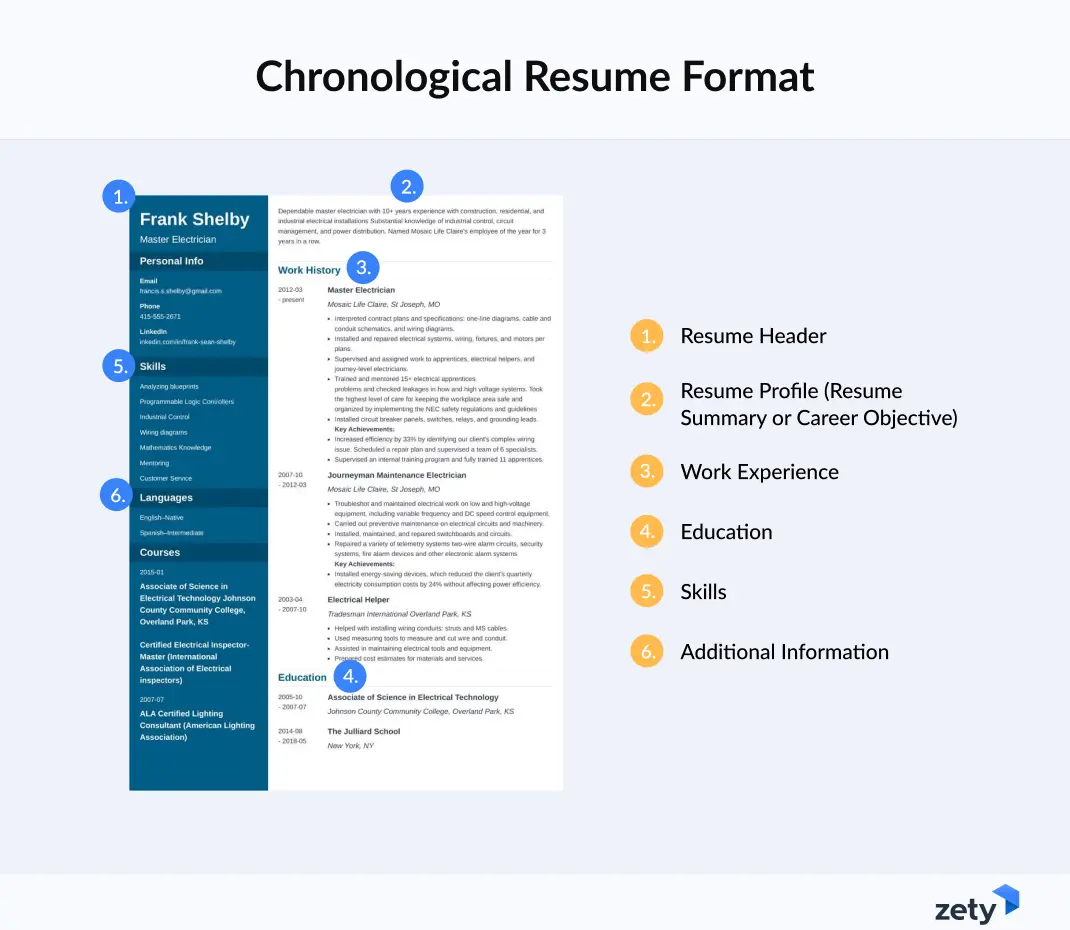
A chronological resume format, also called a reverse-chronological resume format, is perfect for candidates who remain in the same area of work and seek employment similar to their previous jobs.
When choosing this resume format, you list your relevant work experience, starting with the most recent one. You then continue to list your positions and relevant achievements going backward, placing them in reverse chronological order.
So, whether you’re writing an accounting resume, an IT manager resume, a nurse resume, a law student resume, or any other resume, this format might work out. It’s the most versatile one, which makes it suitable for most professions.
It’s the ideal resume format for experienced candidates with a solid, continuous employment track record. It's my personal choice influenced by my career journey—I've consistently been involved in roles centered around content creation.
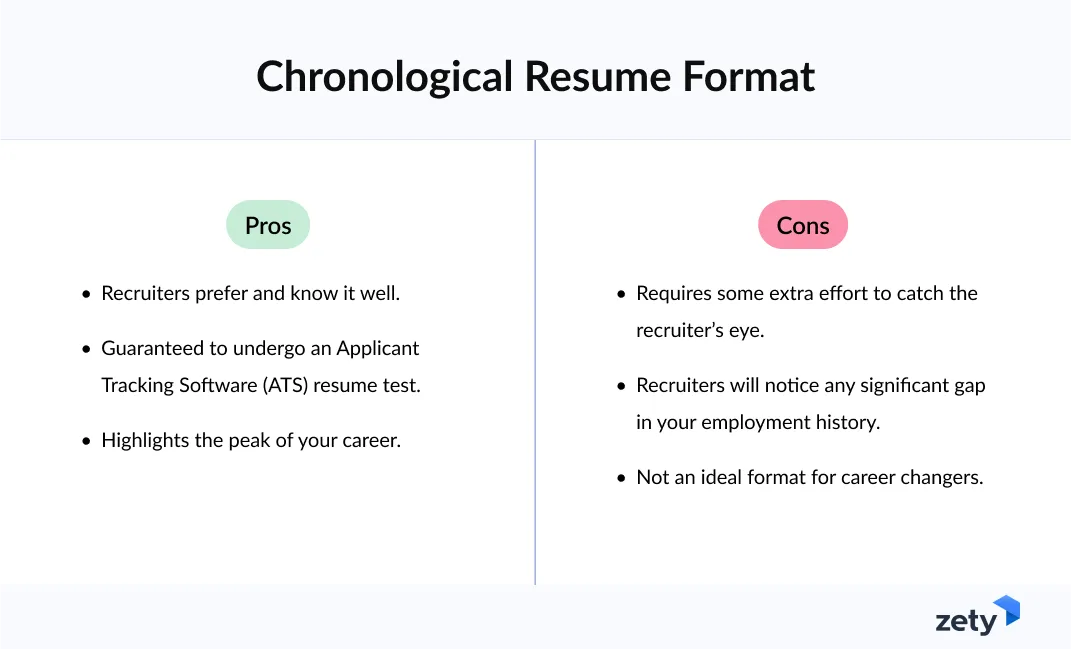
2. Functional Resume Format
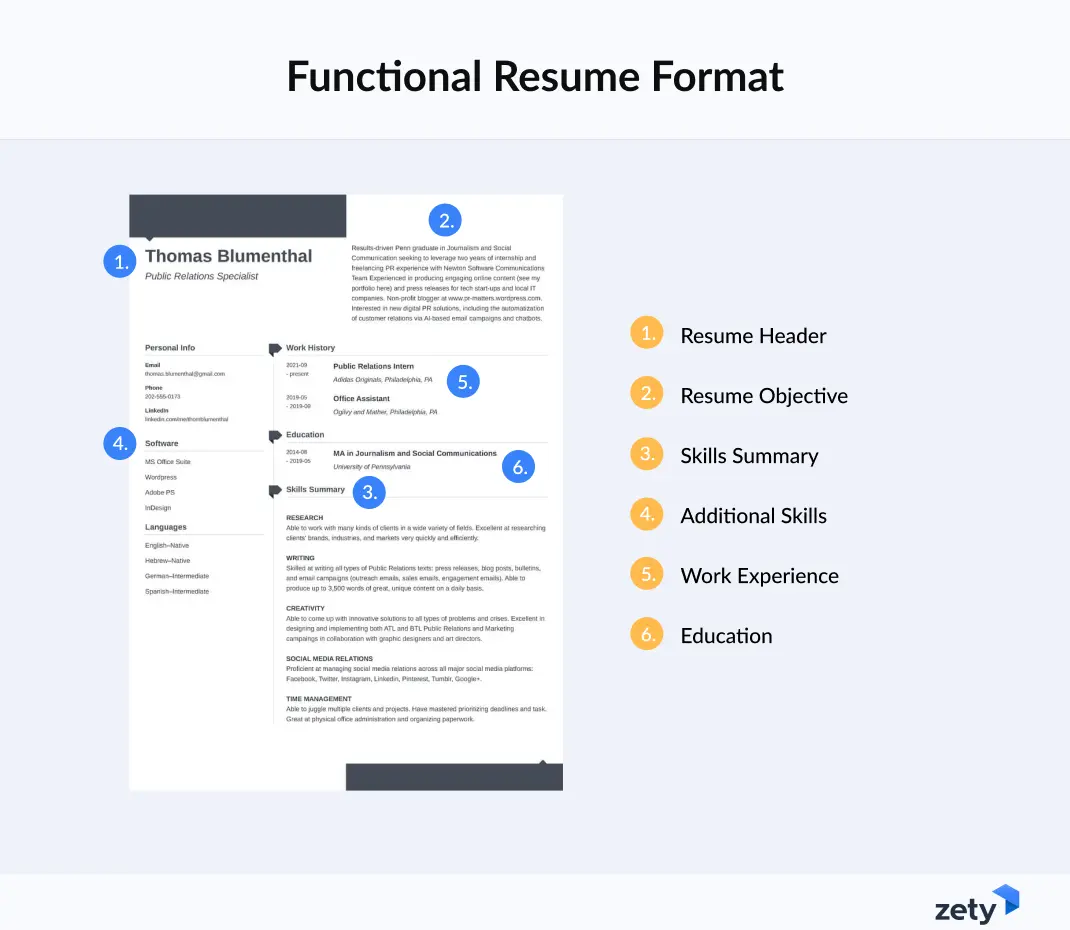
I always recommend choosing a functional resume, or skill-based resume, if you’re one of these three types of candidates:
- Creative workers. The functional resume will give you creative space to highlight your skills. Just remember to add a portfolio to confirm your abilities.
- Veterans. Highlighting a detailed military work experience in any other resume format is tricky. Recruiters are usually not familiar with these types of qualifications. Sowing your abilities might be a better idea.
- Overqualified candidates. Having tons of relevant experience is valuable but often difficult to show on your resume. Sometimes it’s easier to show your skills instead. Especially considering what’s easier for your recruiter to wrap their heads around.
To be more specific, if you’re a graphic designer, military transitioner, or Chief Executive Officer, your resume should be formatted skill-based.
This format focuses on your key skills and your abilities are more important than when and where you’ve gained them. It’s a perfect resume format for people who are targeting entry-level jobs, veterans, and non-traditional industries.
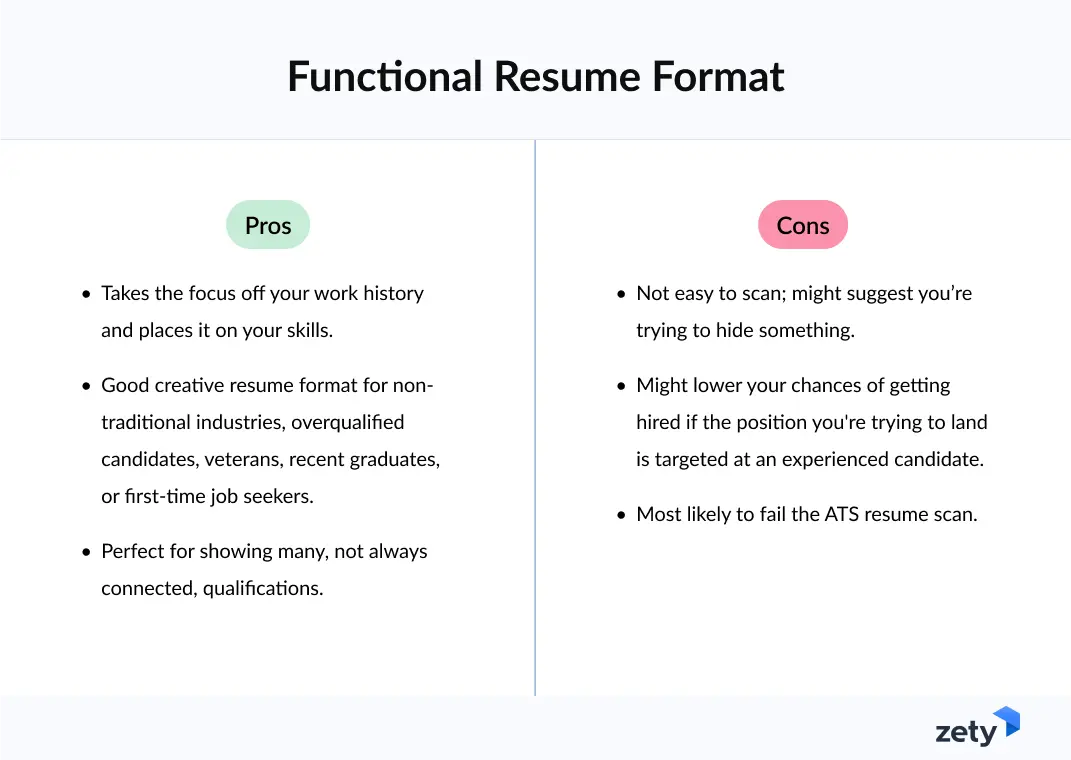
3. Combination Resume Format
 A combination resume format, also called a hybrid resume format, is a great choice for three different types of candidates:
A combination resume format, also called a hybrid resume format, is a great choice for three different types of candidates:
- Seasoned professionals. A combination resume is ideal for showcasing your key achievements if you have a long career.
- Career-changers. If you haven’t worked in your new industry yet, but have gained relevant skills in other roles, this is also a great resume format for you to choose.
- Job-seekers with employment gaps and valuable experience. It’s easy to show your achievements with this resume format. If you can show them clearly, your recruiters will overlook the gaps.
A combination resume is perfect for you if you’re an experienced marketing director, senior software engineer, or a stay-at-home mom who’s either returning to the job market or following a new career path.
This format balances your experience and skills, making it ideal if you’re torn between a reverse-chronological or skills-based resume. The combination format integrates both styles, emphasizing your abilities in the skills summary and validating them with concrete examples in the work experience section.

What Resume Format is Perfect for You
Before we move on to our next chapter, let’s do a test:
- Are you applying for a job where your portfolio is more important than your resume? Are you transitioning from military to civilian life? Are you worried about being overqualified? If so, go for a functional resume.
- Are you an experienced professional with a lot to showcase? Are you changing careers or exploring a new field? Do you have gaps in your employment history? If any of these apply to you, use a combination resume.
- None of these apply? Stick with the traditional reverse-chronological resume format.
Take a quick look at this resume format comparison to be 100% sure you picked the right resume format:

Now that you know which format is best for you, let me guide you through your next important step: choosing a great resume template.
There is another one. It's not really a format but an exciting way to show your skills and experience. Read more: Infographic Resume Templates.
Making a resume with our builder is incredibly simple. Follow our step-by-step guide, use ready-made content tailored to your job and have a resume ready in minutes.
When you’re done, Zety’s resume builder will score your resume and our resume checker will tell you exactly how to make it better.
Resume Templates With Different Design Formats
Whatever job you’re after, you can’t get wrong with professional resume templates. Here, you’ll find some examples from our builder that are ready to make in just a few clicks. They are also ATS-friendly, and you can freely adjust them to your needs.
1. Top Performing Chronological Resume Format
Cascade was always my personal weapon of choice when it came to conquering recruiters' hearts. I even used it to land my job at Zety! Needless to say, #NailedIt. It has a very universal design with lots of white space. It is a highly recommended modern resume template for job applications in conservative fields: law, finance, and general business.
2. Elegant Chronological Resume Format
Our template Diamonds highlights the key areas: section headings, skill levels, and bullets in the work history section. Full-width from top to bottom (no side column featured) makes it easy to go through your work history chronologically. This eye-catching resume template is excellent for candidates with many years of experience. I can definitely see myself using it if I ever consider a career switch.
3. Simple Chronological Resume Format
Our Simple resume template includes one of my favorite features that I always recommend adding: resume icons. When used effectively, they make it easier for recruiters to navigate your resume without even reading the headings, giving them more time to focus on your qualifications. For me it’s a bit too simple, but I still think it can be very impactful.
4. Modern Functional Resume Format
If a corporate pro asks me what template I would recommend, I always go with Modern. It’s a simple, elegant, yet unique resume template with two blocks of content to separate your skills section and work experience from other personal details. A sidebar for your personal info and extra sections lets you save space and fit more information onto a single page.
5. Professional Combination Resume Format
I'd say Cubic is the prettiest resume format available in our builder. It’s a perfect combination of classical elegance and modern creativity. Subtle shading helps guide the reader's eyes across different sections. The side column for contact details and skills adds a dynamic twist to the design. This visual resume template is an excellent choice for applicants hunting jobs in IT, marketing, or sales.
By now, you don’t want just any resume. You want a resume that’s simply perfect. Read this guide: How to Write a Perfect Resume.
Resume Formatting Checklist
Below, you’ll find a quick resume format checklist. Use it after writing a resume to ensure you’ve included everything you need.
✅ The resume uses a simple, text-based template without tables, graphics, or multiple columns to ensure ATS compatibility.
✅ The font is professional and easy to read (Arial, Calibri, Helvetica, or Times New Roman).
✅ The font size is appropriate (10–12 pt for body text, 14–16 pt for section headers).
✅ Formatting is consistent throughout the resume, including fonts, bullet styles, and date formats.
✅ Bullet points are used instead of paragraphs to improve readability and highlight key achievements.
✅ The resume is saved as a PDF, unless the job posting requests a different format (e.g., .docx).
✅ Section headings are standard and ATS-friendly ("Work Experience," "Education," "Skills").
✅ Margins are set between 0.5” and 1”, with text left-aligned or justified for a clean layout.
✅ The resume length is appropriate (one page for entry-level, two pages for extensive experience).
✅ Job titles are bolded, and company names are italicized or capitalized for better scannability.
✅ The resume has been thoroughly proofread to eliminate typos, grammar mistakes, and formatting errors.
If you checked all the boxes, your resume is professionally formatted and ready to submit!
Now that you know all there is to know about a resume format, it’s time to learn how to format a cover letter. Find out how to ace it: Cover Letter Format.
Plus, a great cover letter that matches your resume will give you an advantage over other candidates. You can write it in our cover letter builder here. Here's what it may look like:
See more cover letter templates and start writing.
Expert Curated Video Content
If you prefer to watch a video, our Certified Professional Resume Writer, Caio, will guide you through all main resume formats, and more:
Do you have any questions about choosing the best resume format for your position? Is there anything else you’d like to know about formatting a resume? Give me a shout in the comments.
About Zety’s Editorial Process
This article has been reviewed by our editorial team to make sure it follows Zety's editorial guidelines. We’re committed to sharing our expertise and giving you trustworthy career advice tailored to your needs. High-quality content is what brings over 40 million readers to our site every year. But we don't stop there. Our team conducts original research to understand the job market better, and we pride ourselves on being quoted by top universities and prime media outlets from around the world.

